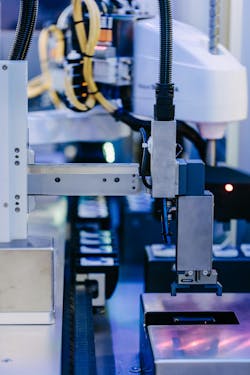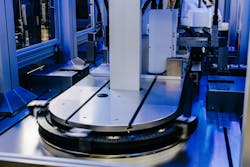JR Automation Uses Beckhoff’s XTS in its Modular Assembly Platform
With its FlexChassis modular assembly platform, JR Automation, a Hitachi Group company, allows manufacturers to start with a small system for product testing or proof of concepts. From there, they can rapidly scale to series production with built-in OEE (overall equipment effectiveness) monitoring and quality control functionality knowing that they can add capacity, customize processes, or retool for new products as needed.
The assembly capabilities of FlexChassis include ultrasonic welding, riveting, screwing, snap fitting, gluing, decorating, heat sealing and joining dissimilar materials. Material joining capabilities include heat or ultrasonic foil sealing, laser tacking, laser ablation, laser or ultrasonic cutting and die cutting.
FlexChassis can deliver high throughputs greater than 45 parts per minute and has low footprint requirements for an assembly station of its capabilities. Its clean manufacturing features include HEPA filtration, support for various ISO classes and a stainless-steel construction for hygienic applications. And with Beckhoff’s PC-based control, users have access to intuitive dashboards where they can set alarms and drill down into operations analytics.
David Vitale, chief engineer, digital solutions at JR Automation, noted that “IoT and track and trace are very important functions that are native to the FlexChassis system for downtime management, quality management and OEE. Performance data is gathered from the system using a local Beckhoff embedded PC through our Ignition-based MES functions. These are stored on local databases, but they can be hosted in the cloud or elsewhere as desired.”
Initially geared toward the life sciences market, FlexChassis now extends clean manufacturing capabilities to other industries, such as semiconductor, automotive, battery and e-mobility, food and beverage, and e-commerce.
JR Automation’s engineers didn’t want inflexible material handling to be a stumbling block to FlexChassis modularity, so they sought out adaptive linear transport tech that could accommodate constant change. That’s when they turned to Beckhoff and its eXtended Transport System (XTS).
“JR Automation chose the Beckhoff XTS due to its speed and modular design that allows for multiple configurations,” said Mick Trompen, chief engineer, life sciences at JR Automation. “Plus, we had ample previous experience with the linear transport system and our customers have been very impressed with the performance of XTS.”
Adaptive automation
XTS consists of linear motor modules, passive wireless movers and mechanical guide rails, all with multiple geometries to create any path imaginable. XTS motor modules integrate all power electronics, EtherCAT communication and position measurement into a compact form factor. Cabling is kept to a minimum by daisy chaining motor modules together via a direct connection.
“The motor modules’ simple configuration and track layout worked well for our concept,” explained David Shiles, senior controls engineer at JR Automation. “The XTS allows us to achieve high OEE and high throughput with enhanced flexibility. We are taking on assemblies with more steps and at higher throughput rates than ever before.”
Unburdened by cables, electromagnetic forces propel the movers around the customizable track with speeds reaching 4 m/s and accelerations up to 100 m/s2. Movers can operate individually or in groups, supporting true adaptive automation that:
- Raises throughput by increasing tooling to 2-up or more at the slowest process stations.
- Allows engineers to easily add stations for high-mix, low-volume production.
- Rejects defective product more efficiently by skipping stations after detecting flaws.
- Offers rapid, software-based changeovers for new products or emergency orders.
Space savings also appealed to the JR Automation team. The XTS technology’s compact and integrated design eliminates outmoded mechanical components such as belts, chains and indexing tables. This typically shrinks machine footprints by roughly 50%.
“The XTS helps us build high-speed assembly automation,” said Chris Moritz, applications engineer at JR Automation. “It allowed us to raise the ceiling for the throughput and complexity we can take on, particularly with the FlexChassis platform.”
Easier reengineering
A key driver behind the development of the FlexChassis was how frequently the JR Automation team noticed that reengineering was slowing many of its customers’ projects. Having to redesign a machine’s base and material handling technologies often took engineers’ and operators’ attention away from optimizing their own processes and products.
With FlexChassis, users don’t even need to spec dimensions or fabricate a machine base. With modules measuring 1 meter by 1.5 meters wide and 2.44 meters tall, FlexChassis users can more easily construct work cells as needed that support a wide range of robotics and other bolt-on equipment.
Communication boosts flexibility
The ability for FlexChassis to use a broad selection of robots, end effectors, tooling and sensors for the array of assembly applications it can handle requires rapid communication via various industrial protocols and fast cycle times.
The EtherCAT industrial Ethernet system delivers the necessary speed and flexibility, according to Shiles. “I prefer EtherCAT from a performance standpoint. In addition to real-time performance, it’s better at using the speeds of the medium the data is exchanged over,” he said.
EtherCAT’s openness was critical, too. “We have many customers in North America, so being able to interface with different systems is paramount to winning some projects when the customer has existing systems they’re familiar with and would prefer not to change,” Shiles added.
That’s why Beckhoff offers gateways and bus couplers to more than 30 other protocols, including EtherNet/IP, Profinet and IO-Link, along with an expansive portfolio of I/O terminals. EtherCAT also offers a flexible selection of topologies without performance loss and a network size of up to 65,535 nodes on one network, with zero managed switches.
Real-time EtherCAT communication is necessary for XTS and to coordinate with robotics and other tooling at high speeds. Here, a CX2072 embedded PC from Beckhoff offers extreme computing power with many-core Intel Xeon processors. “This is the only way to meet the necessary scan time of 250 microseconds to process the XTS data in addition to dedicated cores for PLC, servo control and machine vision,” Shiles said.
To program the FlexChassis’ wide-ranging functionality, JR Automation engineers rely on Beckhoff’s TwinCAT 3 automation software. TwinCAT offers an end-to-end engineering and runtime platform and supports a range of programming standards, including all IEC 61131-3 languages and their object-oriented extensions, predefined or custom function blocks, and computer science standards in Microsoft Visual Studio.
TwinCAT empowered JR Automation engineers to rapidly commission the first FlexChassis system, which served as a demo for customer meetings and trade shows. The XTS platform sped this development through an intuitive configurator and a suite of diagnostic and visualization tools that can be used in simulation or on real hardware.
“The software for this project was actually written for a previous project, but the goal was to write it in a way that it didn’t matter what type of PLC was interfacing with the FlexChassis,” Shiles said, explaining that the FlexChassis project required transparent communication between the Beckhoff IPC and third-party PLCs for future extensibility. “From the outset, our team created data communication structures and determined how to transmit data in a manner that easily scales as the system’s size or complexity grows,” he said.
See this video about JR Automation's use of Beckhoff technologies.
About the Author

Leaders relevant to this article:



